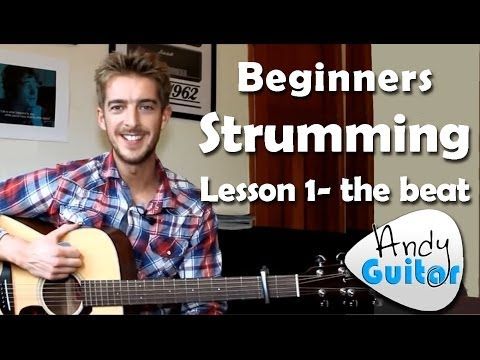In this video
A beginners guitar lesson where we learn to play the most simple strumming pattern and how to keep in time. We then look at how to hear the beat in real songs so you can play along to your favourite songs!
>> For more lessons like this why not check out my Strumming Course?
What are bars and beats?
The beat is what you nod your head or tap your foot to when you hear a song you like. It is a pulse in music that everything lines up to. 99% of the time, a song will use a count of 4 beats, which we call a bar. Whatever strumming we do for 1 bar, we tend to repeat this throughout an entire song. So when you look at a song, only 1 bar of strumming may be shown, which you learn to repeat while playing whatever chord is written. How fast you count this 1, 2, 3, 4 is called the tempo, aka speed or bpm (beats per minute)
Beat- what you tap your foot to
Bar- 4 beats, to a count of 1 ,2, 3, 4
Tempo (aka bpm)- the speed of this count
Strumming Pattern 1- Spreads
This is where we strum once per bar on beat 1. The chord should ring out for the rest of the bar.
This is a great place to start when learning any new song as it gives you chance to learn the chord changes. Plus- many real songs actually start like this! Count 1, 2, 3, 4 at a slow, even pace (out loud if needs be) and strum an E chord every time you say beat 1.
Strumming Pattern 2- 4th Strumming (On the Beat)
After 'Spreads', 4 down strums on each beat should be seen as the default strumming pattern when first learning any new song. Keep the pace and volume even (imagine playing to a slightly fast ticking clock)
4 down strums on the beat can be written like this. The ‘D’ and the arrows represent down strums, the ’1 2 3 4′ is the beat, and the symbols mean a 1 beat strum.

The strumming for any song is only shown as a 1 bar pattern. This is generally repeated for an entire song. See the example below showing a bar of E and a bar of A with on the beat strumming. A double line shows where this repeats.

You should now try and play a chord sequence and strumming pattern alone, then try it over the drum beat in the video below!
Exercise 1- Play the chord sequences below tin time with the drum loop video provided
Chord sequence 1 (Easy)
Strum an E chord on every beat to a slow count. This should also be done along with Andy in the video above. Repeat this a few times, then try along to the drum track below!
Chord sequence 2 (Medium)
Strum E on beat 1, then A on beat 1 of the next bar. Repeat this a few times to a slow even count, then try along to the drum track below! N.B. Just strumming an E on beat 1 can be used as an easier alternative to get started.

Chord sequence 3 (Hard for a total beginner)
Play a bar of E then a bar of A on the beat to an even count for around 2 minutes, then do this along to the drumbeat.

Being able to do this is the overall goal of this entire level. There are some great songs to try out, but if you can do this along to the drumbeat then feel free to move ahead to level 2!
TOP TIP- Begin on a cymbal to know that you have started on beat 1!
There are more complex strumming patterns shown in some of the songs at Level 1 of my beginner’s course. Feel free to have a go at them, but please see this ‘on the beat’ strumming as your default for every time you learn a new song or chord sequence.


